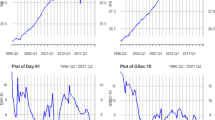Abstract
This paper focuses on the causes of instability of money demand in Tunisia between 1973 and 2013. It has been argued that the main explanatory factors of money demand are national income, monetary market rate and exchange rate. We tested Ambler and McKinnon hypothesis (1985), which assumes that instability is explained by the absence of the nominal exchange rate in the specification of money demand. We found that structural changes are explained by the dependence of the national economy to world shocks, the IMF’s structural adjustment programme at the end of 1986.
Similar content being viewed by others
Notes
The implementation of financial reforms has raised doubts about the use of monetary aggregates to stabilize inflation rates. The Central Bank of Tunisia (CBT) switches between instruments of monetary policy by moving away from policies that influence money supply towards those that influence bank rates. Monetary policy is an important component of macroeconomic policy, which aims at maintaining macroeconomic stability and price stability.
References
Ambler, S., and R. McKinnon. 1985. U.S. Monetary Policy and the Exchange Rate: Comment. American Economic Review 75: 557–559.
Andrews, D.W.K., and W. Ploberger. 1994. Optimal tests when a nuisance parameter is present only under the alternative. Econometrica 62 (6): 1383–1414.
Andrews, W.K. 1993. Tests for parameter instability and structural change with unknown change point. Econometrica 61 (4): 821–56.
Andrews, W.K. 1993. Tests for parameter instability and structural change with unknown change point. econometrica 61: 821–856.
Bagshaw, M.L. 1983. Extension of Granger causality in multivariate time series models. The Federal Reserve Bank of Cleveland, WP \(\text{n}^{\circ }\)8303.
Bahmani-Oskooee, M., and M. Pourheydarian. 1990. Exchange rate sensitivity of demand for money and effectiveness of fiscal and monetary policies. Applied Economics 22: 917–925.
Bahmani-Oskooee, M., and H. Rehman. 2005. Stability of the money demand function in Asian developing countries. Journal of Applied Economics 37: 773–792.
Bahmani-Oskooee, M., and G. Abera. 2009. How stable is the demand for money in African countries. Journal of Economic Studies 36 (3): 216–235.
Buch, C. 2001. Money demand in hungary and poland. Applied Economics 33: 989–999
Bai, J., and P. Perron. 1998. Estimating and testing linear models with multiple structural changes. Econometrica 66: 47–78.
Chow, G.C. 1960. Tests of equality between sets of coefficients in two linear regressions. Econometrica 28 (3): 591–605.
Dickey, D.A., and W.A. Fuller. 1979. Distribution of the Estimators for Autoregressive Time Series with a Unit Root. Journal of the American Statistical Association 74: 427–431.
Dickey, D.A., and W.A. Fuller. 1981. Likelihood Ratio Statistics for Autoregressive Time Series with a Unit Root. Econometrica 49: 1057–1072.
Ftiti, Z., K. Guesmi, F. Teulon, and D.K. Nguyen. 2015. Modelling inflation shifts and persistence in Tunisia: perspectives from an evolutionary spectral approach. Applied Economics 47 (57): 6200–6210.
Glynn, J., N. Perera, and R. Verma. 2007. Unit root tests and structural breaks: a survey with applications. Journal of Quantitative Methods for Economics and Business Administration 3 (1): 63–79.
Granger, C.W. 1969. Investigating Causal Relations by Econometric Models and Cross-spectral Methods. Econometrica 57 (3): 424–438.
Haugh, L.D. 1972. The identification of time series interrelationships with special reference to dynamic regression. Ph.D. Thesis, Department of Statistics, University of Wisconsin, Madison.
Kwiatkowski, D., P.C.B. Phillips, P. Schimidt, and Y. Shin. 1992. Testing the null hypothesis of stationary against the alternative of a unit root. Journal of Econometrics 54: 159–178.
McKinnon, R., et al. 1984. International Influence on the U.S. Economy: Summary of an Exchange. American Economic Review 74: 1132–1134.
McKinnon, R.I. 1985. Two concepts of international currency substitution, In: The economics of the Caribbean basin, eds. M.D. Connoly, Josh McDermott, pp. 101–130 New York: McDermott, Praeger.
Nelson, C.R., and C.I. Plosser. 1982. Trends and random walks in Macroeconomic Time Series. Journal of Monterey Economics 10: 139–162.
Ng, S., and P. Perron. 1995. Unit root tests in ARMA models with data dependent methods for the selection of the truncation lag. Journal of the American Statistical Association 90: 268–281.
Perron, P. 1989. The great crash, the oil price shock, and the unit root hypothesis. Econometrica 57: 1361–1401.
Perron, P. 1997. Further evidence on breaking trend functions in macroeconomic variables. Journal of Econometrics 80 (2): 355–385.
Peytrignet, M. 1996. Stabilité économétrique des agrégats monétaires suisses. Swiss National Bank Quarterly Bulletin 3 (96): 251–278.
Pierce, D.A. 1975. Forecasting in dynamic models with stochastic regressors. Journal of Econometrics 3: 349–374.
Pierce, D.A., and L.D. Haugh. 1977. Causality in temporal systems: characterizations and a survey. Journal of Econometrics 5: 265–293.
Pradhan, Basanta K., and A. Subramanian. 2003. On the stability of demand for money in a developing economy: Some empirical issues. Journal of Development Economics 72: 335–351.
Quandt, R.E. 1960. Tests of the hypothesis that a linear regression system obeys two separate regimes. Journal of the American Statistical Association 55 (290): 324–330.
Reese, S. 2012. Are tests for smooth structural change affected by data inaccuracies? A simulation study. Lunds Universitet Working paper: 1–19.
Sims, C.A. 1972. Money, income, and causality. American Economic Review 62: 540–52.
Todani, K. 2007. Long-run M3 demand in South Africa: A cointegrated VAR Model. South African Journal of Economics 75: 681–692.
Zivot, E., and W.K. Andrews. 1992. Further evidence on the great crash, the oil-price shock, and the unit-root hypothesis. Journal of Business & Economic Statistics 10: 251–270.
Author information
Authors and Affiliations
Corresponding author
Rights and permissions
About this article
Cite this article
Mgadmi, N., Rachdi, H., Saidi, H. et al. On the Instability of Tunisian Money Demand: Some Empirical Issues with Structural Breaks. J. Quant. Econ. 17, 153–165 (2019). https://doi.org/10.1007/s40953-018-0123-x
Published:
Issue Date:
DOI: https://doi.org/10.1007/s40953-018-0123-x




